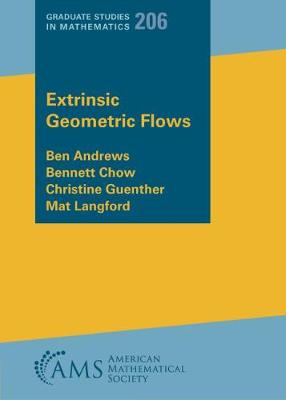Graduate Studies in Mathematics
2 total works
Extrinsic Geometric Flows
by Ben Andrews, Bennett Chow, Christine Guenther, and Mat Langford
Published 1 June 2020
Extrinsic geometric flows are characterized by a submanifold evolving in an ambient space with velocity determined by its extrinsic curvature. The goal of this book is to give an extensive introduction to a few of the most prominent extrinsic flows, namely, the curve shortening flow, the mean curvature flow, the Gauss curvature flow, the inverse-mean curvature flow, and fully nonlinear flows of mean curvature and inverse-mean curvature type. The authors highlight techniques and behaviors that frequently arise in the study of these (and other) flows. To illustrate the broad applicability of the techniques developed, they also consider general classes of fully nonlinear curvature flows.
The book is written at the level of a graduate student who has had a basic course in differential geometry and has some familiarity with partial differential equations. It is intended also to be useful as a reference for specialists. In general, the authors provide detailed proofs, although for some more specialized results they may only present the main ideas; in such cases, they provide references for complete proofs. A brief survey of additional topics, with extensive references, can be found in the notes and commentary at the end of each chapter.
The book is written at the level of a graduate student who has had a basic course in differential geometry and has some familiarity with partial differential equations. It is intended also to be useful as a reference for specialists. In general, the authors provide detailed proofs, although for some more specialized results they may only present the main ideas; in such cases, they provide references for complete proofs. A brief survey of additional topics, with extensive references, can be found in the notes and commentary at the end of each chapter.
Ricci flow is a powerful analytic method for studying the geometry and topology of manifolds. This book is an introduction to Ricci flow for graduate students and mathematicians interested in working in the subject. To this end, the first chapter is a review of the relevant basics of Riemannian geometry. For the benefit of the student, the text includes a number of exercises of varying difficulty. The book also provides brief introductions to some general methods of geometric analysis and other geometric flows. Comparisons are made between the Ricci flow and the linear heat equation, mean curvature flow, and other geometric evolution equations whenever possible. Several topics of Hamilton's program are covered, such as short time existence, Harnack inequalities, Ricci solitons, Perelman's no local collapsing theorem, singularity analysis, and ancient solutions. A major direction in Ricci flow, via Hamilton's and Perelman's works, is the use of Ricci flow as an approach to solving the Poincare conjecture and Thurston's geometrization conjecture.

